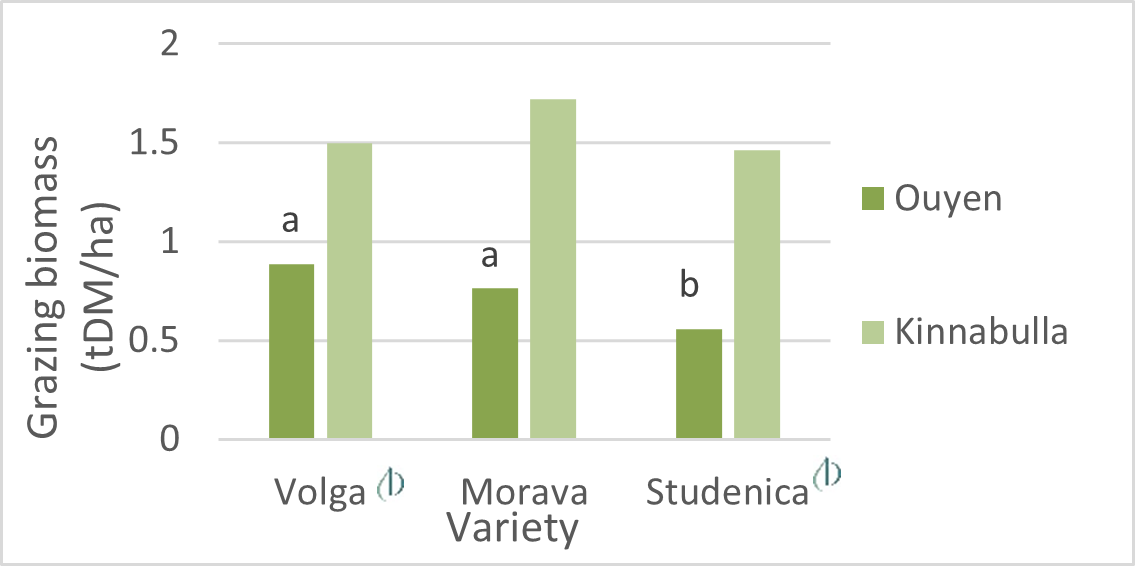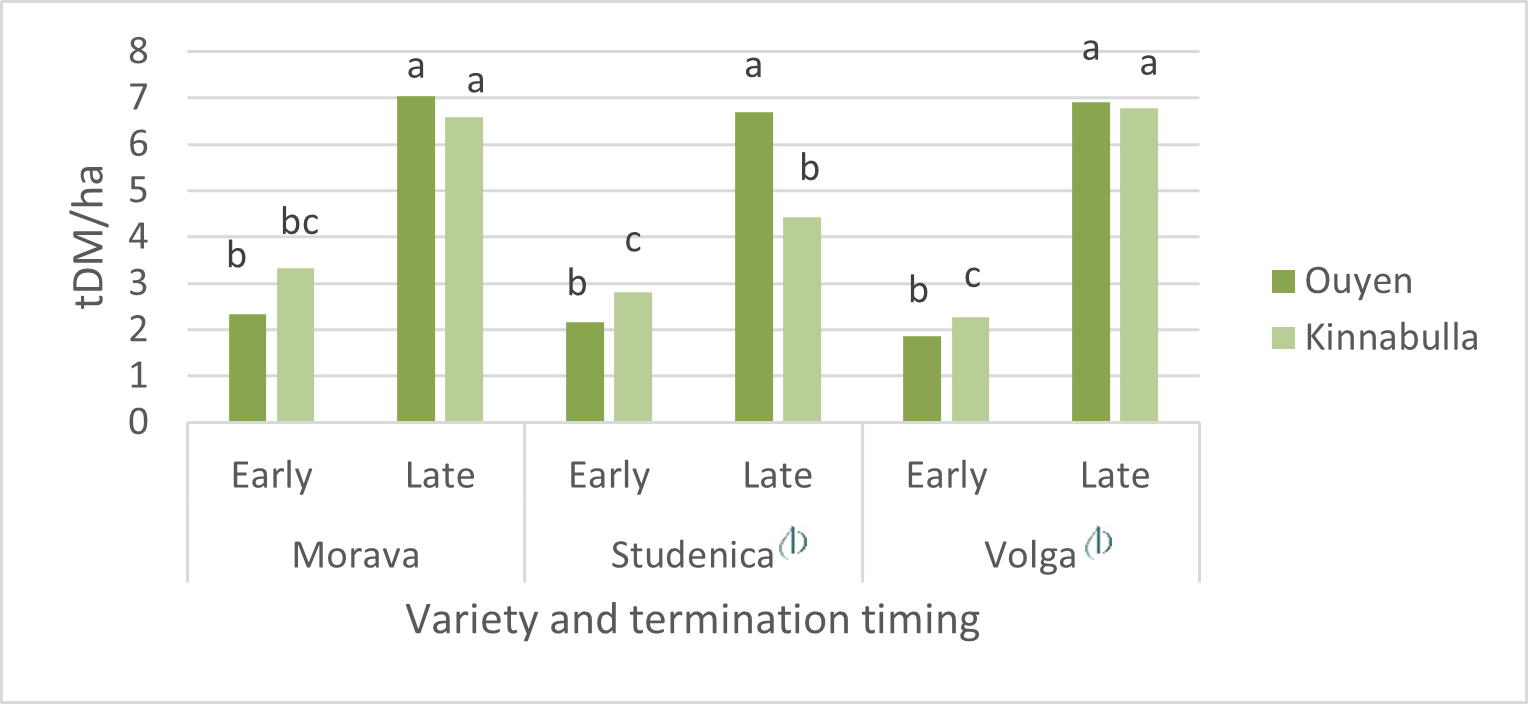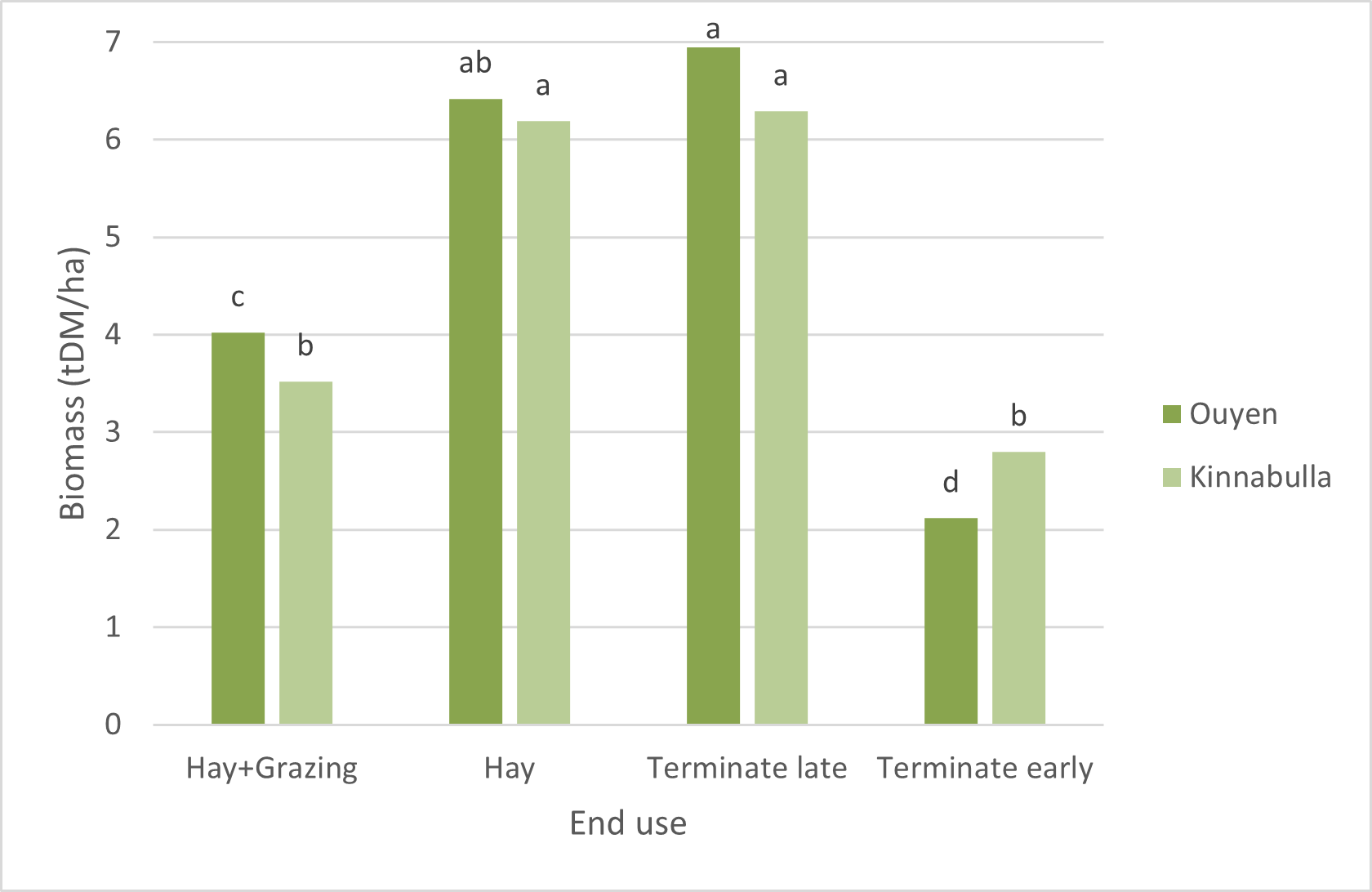Vetch end use and how it affects the cropping rotation
Vetch end use and how it affects the cropping rotation
Author: Brooke Bennett (Birchip Cropping Group) | Date: 20 Feb 2024
Take home messages
- Delaying the brown manure termination timing by 4–6 weeks doubled biomass production.
- Morava and Volga produced the most grazing biomass and highest hay yield.
- As expected, crops terminated later in the season use more moisture, but may leave behind more nitrogen for subsequent crops.
Background
Common vetch (Vicia sativa) has been grown in the Victorian Mallee for many years as a common crop rotation for farms due to its versatility. Vetch can be utilised as a disease break, a grass weed break and is sown for several end uses including grazing, hay, brown manure or harvested for seed. It is known that sowing vetch earlier will increase biomass for grazing and hay yield (GRDC 2018). It has also been reported that there is a trade-off made in brown manure timings. The earlier the termination timing, the higher the soil moisture left behind but the lower the nitrogen (N) fixed. In contrast, the later the termination timing, higher levels of soil mineral N are left behind but this is quite often coupled with lower soil moisture levels (Ferrier et al. 2012). It is not well understood how the agronomic decisions made during the season affect soil moisture and soil mineral N levels following the vetch phase, and what outcome this has on yield and quality of the subsequent crop. Agronomic decisions to consider, tested as part of this research, are grazing, variety choice and therefore maturity of vetch and termination timing.
The aim of this research was to evaluate the effect of agronomic decisions on vetch end uses and soil moisture and soil mineral N following the end use. The outcomes of the vetch phase are analysed here, and the trials will be sown to a cereal in 2024 to assess the effect on the subsequent crop.
Method
Two replicated field trials were sown at Ouyen and Kinnabulla on 19April and 20 April using a complete randomised block trial design. Three varieties were chosen for this trial with differing maturities: Morava (late maturity), Volga (early) and Studenica (very early). The in-season treatments included grazing which was carried out just prior to canopy closure during mid-July. Two termination timings were also studied. The earlier termination timing was undertaken four months after sowing for all varieties, irrespective of growth stage, whereas the late termination timing and hay cut timing was determined by variety maturity, being terminated or cut for hay when the variety reached 50% flat pod formation. One treatment was untreated throughout the season and harvested for grain. Assessments included grazing biomass yield, hay yield, feed test quality, grain yield, soil N and soil moisture. Soil sampling was carried out at a site level prior to sowing to get a baseline understanding of the sites’ soil moisture and soil mineral N. Post-harvest soil tests were carried out per plot to determine soil mineral N and plant available water (PAW) to a depth of 1m and segmented into 0–10cm, 10–40cm, 40–70cm and 70–100cm depths. The two trials were analysed separately using one-way ANOVA.
Results and discussion
Grazing
Statistical analyses showed a significant difference between grazing biomass produced at the Ouyen trial (Figure 1) for the varieties Morava and Volga, which produced more biomass than Studenica. This differed from the grazing biomass produced at the Kinnabulla trial, where no significant differences in biomass were detected between varieties (Figure 1).

Figure 1. Grazing biomass (t DM/ha) of three varieties of vetch in mid-July at Ouyen and Kinnabulla. The sites were analysed separately. Columns with different letters show significant difference. Ouyen P=0.001, Lsd 0.16t DM/ha, CV 19.6%, Kinnabulla = NS, Lsd 0.27t DM/ha, CV 16.6%.
Termination timing of brown manure treatments
There were large differences in the amount of biomass produced between the early and late brown manure termination timings. An additional 4.79tDM/ha and 3.49tDM/ha were produced at Ouyen and Kinnabulla, respectively, in the later termination timing. The only difference in variety performance across both sites was that less biomass was produced in the late termination timings of Studenica at Kinnabulla compared to Volga and Morava (Figure 2).

Figure 2. Biomass at termination timing (t DM/ha) of vetch varieties at Kinnabulla and Ouyen. Columns with different letters show significant difference within a site. The sites were analysed separately. Kinnabulla P<0.001, Lsd 1.16t DM/ha, CV 17.4%, Ouyen P<0.001, Lsd 1.29t DM/ha, CV 18.7%.
Hay yield
At Kinnabulla, Morava and Volga had the highest hay yields at 6.04tDM/ha and 5.49tDM/ha, respectively (Figure 3). At Ouyen, there were no significant hay yield differences between varieties. A large yield penalty occurred in the hay treatments that had been grazed earlier in the season at both sites (Figure 4). Additionally, Volga recovered the best from grazing at both sites, with the lowest loss of 0.96tDM/ha when considering the combination of biomass removed at grazing and the hay cut (data not shown).

Figure 3. Hay yield (t DM/ha) of varieties at Ouyen and Kinnabulla. Columns with different letters show significant difference. The sites were analysed separately. Ouyen = NS, Kinnabulla P<0.001, Lsd 1.86t DM/ha, CV 26.7%.

Figure 4. Biomass response to end use at Ouyen and Kinnabulla. Columns with different letters show significant difference within a site. The sites were analysed separately. Ouyen P <0.001, Lsd 0.79t DM/ha, CV 11.1%, Kinnabulla P<0.001, Lsd 1.42tDM/ha, CV 13%.
Hay quality
Feed test analyses showed acceptable quality across all treatments and varieties (Table 1) (treatment data not shown). Studenica had marginally higher metabolisable energy and crude protein levels than the other two varieties, which may suggest that cutting time has an effect. Studenica hay is an earlier maturing variety and thus was cut 2–4 weeks earlier than Volga and Morava.
Table 1. Hay quality of vetch varieties.
Variety | Metabolisable energy (MJ/kg DM) | Crude protein (%) | NDF (%) | |||
|---|---|---|---|---|---|---|
Kinnabulla | Ouyen | Kinnabulla | Ouyen | Kinnabulla | Ouyen | |
Studenica | 10.26ab | 10.42a | 20.79a | 21.10a | 39.09 | 38.71b |
Volga | 10.59a | 9.61b | 18.37b | 18.88b | 38.28 | 41.74a |
Morava | 10.00b | 9.74b | 19.02b | 19.76b | 39.45 | 40.46ab |
P value Lsd CV% | 0.012 0.76 5.1 | <0.001 0.36 5.1 | <0.001 2.44 8.7 | 0.003 1.28 8.6 | 0.55 NS 7.9 | 0.007 0.89 6.2 |
Soil moisture and soil mineral nitrogen
Soil measurements taken after harvest indicated the lowest level of plant available water (PAW) and soil mineral N was left behind in the grain harvest treatments (Table 2). Treatments with early termination timings reported the most soil N, which was unexpected given the large differences in biomass produced from the two termination timings (Figure 2). However, the higher amount of soil mineral N at the earlier termination timing is likely owing to increased soil mineralisation (Farquharson et al. 2022). A similar amount of soil mineral N was detected in the late termination treatments and the hay treatments (Table 2). With 3–6tDM/ha of biomass removed in the hay cut treatments, it would be expected that there would be a large difference in these plots. This again illustrates the time needed for the N fixed to break down into available soil mineral N. It is expected that the soil N levels will vary more between treatments when resampled prior to sowing in 2024.
Table 2. The effect of end use decision on plant available water (PAW) (mm) and soil mineral N (kg N/ha) at Kinnabulla.
End use | PAW (mm) | Soil mineral N (kg N/ha) | ||
|---|---|---|---|---|
Kinnabulla | Ouyen | Kinnabulla | Ouyen | |
Early termination | 184.80a | 87.17a | 87.36a | 190.90a |
Hay | 165.60bc | 78.24ab | 72.09b | 145.80bc |
Late termination | 151.30c | 53.01cd | 65.25b | 135.70c |
Grain | 151.00c | 37.99d | 46.73c | 104.30d |
P value Lsd CV% | 0.001 16.01 13.7 | <0.001 17.96 32.7 | <0.001 7.88 16.5 | <0.001 9.78 23.2 |
Conclusion
Morava performed well all throughout the season in 2023 in terms of biomass production, however Volga illustrated versatility; as an early maturing line it has performed similarly to Morava (late maturing) and recovered well from grazing. Studenica’s performance was sub-optimal compared with the other varieties, which is reflective of it being a very early maturing cultivar in a longer-than-average season. Delaying the termination timings by 4–6 weeks significantly increased biomass left behind, and, although not reflected in the immediate soil results, it could result in an additional ~70–95kg N/ha being available for the subsequent crop (using an estimate of 20kg of N being fixed for each tonne of dry matter produced (Peoples et al. 2012)). The trade off in drier years of choosing a later termination timing is there could be less moisture available for the following crop, however, taking into consideration the wet summer so far of 2023/2024, this is unlikely to be demonstrated in this project. In 2023, the vetch hay generated the largest income of the treatments. At the completion of the 2024 season, we will be able to determine if any additional yield for subsequent cereal crops have been generated as a result of the 2023 treatments, and if this leads to increased income/gross margins over the two seasons.
Acknowledgements
The research undertaken as part of this project is made possible by the significant contributions of growers through both trial cooperation and the support of the GRDC, the author would like to thank them for their continued support.
References
Anderson D, Allen R (2021) 2021 Hart trial results: improving vetch dry matter production
Farquharson EA, Ballard RA, Herridge DF, Ryder MH, Denton MD, Webster A, Yates RJ, Seymour NP, Deaker RJ, Hartley E, Gemmel LG, Hackney B, O’Hara GW (2022) Inoculating legumes: practice and science, Grains Research and Development Corporation, Australia. Pp 76-80.
Ferrier D, Watson L, Peoples M (2012) 2012 BCG Season Research Results: Vetch termination: finding a compromise
GRDC (2018) Vetch Grow Notes
Peoples MB, Brockwell J, Hunt JR, Swan AD, Watson L, Hayes RC, Li GD, Hackney B, Nuttall JG, Davies SL, Fillery IRP (2012) Factors affecting the potential contributions of N2 fixation by legumes in Australian pasture systems. Crop and Pasture Science 63, 759-786.
Contact details
Brooke Bennett
Birchip Cropping Group
0468 304 335
brooke.bennett@bcg.org.au
Yolanda Plowman
Birchip Cropping Group
0447 755 312
yolanda.plowman@bcg.org.au
GRDC Project Code: BWD2304-001SAX,
